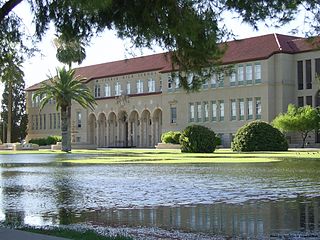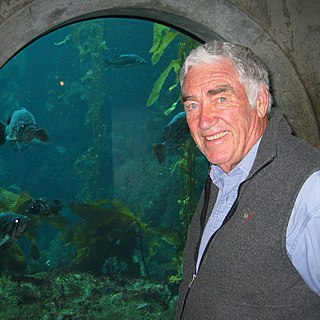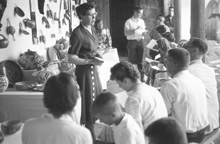
Flagstaff is a city in, and the county seat of Coconino County, Arizona, in the southwestern United States. As of the 2020 United States census, the population was 76,831.

The Southwestern United States, also known as the American Southwest or simply the Southwest, is a geographic and cultural region of the United States that includes Arizona and New Mexico, along with adjacent portions of California, Colorado, Nevada, Oklahoma, Texas, and Utah. The largest cities by metropolitan area are Phoenix, Las Vegas, El Paso, Albuquerque, and Tucson. Before 1848, in the historical region of Santa Fe de Nuevo México as well as parts of Alta California and Coahuila y Tejas, settlement was almost non-existent outside of Nuevo México's Pueblos and Spanish or Mexican municipalities. Much of the area had been a part of New Spain and Mexico until the United States acquired the area through the Treaty of Guadalupe Hidalgo in 1848 and the smaller Gadsden Purchase in 1854.

The Mogollon Rim is a topographical and geological feature cutting across the northern half of the U.S. state of Arizona. It extends approximately 200 miles (320 km), starting in northern Yavapai County and running eastward, ending near the border with New Mexico. It forms the southern edge of the Colorado Plateau in Arizona.

Northern Arizona University (NAU) is a public research university based in Flagstaff, Arizona. Founded in 1899, it was the final public university established in the Arizona Territory, 13 years before Arizona was admitted as the 48th state.

Northern Arizona is an unofficial, colloquially-defined region of the U.S. state of Arizona. Generally consisting of Apache, Coconino, Mohave, Navajo, and Gila counties, the region is geographically dominated by the Colorado Plateau, the southern border of which in Arizona is called the Mogollon Rim.
North Central Arizona is a geographical region of Arizona. It is in the Transition Zone between the Basin and Range Province and the Colorado Plateau, and has some of the most rugged and scenic landscapes in Arizona.

The Arboretum at Flagstaff is a 200-acre (81 ha) arboretum that is home to 750 species of mostly drought-tolerant adapted and native plants representative of the high-desert Colorado Plateau, home to the Grand Canyon and Zion National Park. It is located 3.8 miles (6.1 km) south of U.S. Route 66 on Woody Mountain Road, on the west side of Flagstaff, Arizona, US. The facility is located at 7,150' in elevation, making it one of the highest-elevation public gardens in the United States. The Arboretum has an extensive regional collection of the Penstemon genus and hosts an annual Penstemon Festival.

The Arizona Historical Society (AHS) is a non-profit organization whose mission is to connect people through the power of Arizona's history. It does this through four regional divisions. Each division has a representative museum. The statewide divisions are as follows: Southern Arizona Division in Tucson, the Central Arizona Division in Tempe, the Northern Arizona Division in Flagstaff, and the Rio Colorado Division in Yuma. It was founded in 1884.
Anderson Mesa Station is an astronomical observatory established in 1959 as a dark-sky observing site for Lowell Observatory. It is located at Anderson Mesa in Coconino County, Arizona, about 12 miles (19 km) southeast of Lowell's main campus on Mars Hill in Flagstaff, Arizona.

The Coconino Plateau is found south of the Grand Canyon and north-northwest of Flagstaff, in northern Arizona of the Southwestern United States.

The Arizona National Scenic Trail is a National Scenic Trail from Mexico to Utah that traverses the whole north–south length of the U.S. state of Arizona. The trail begins at the Coronado National Memorial near the US–Mexico border and moves north through parts of the Huachuca, Santa Rita, and Rincon Mountains. The trail continues through the Santa Catalina north of Tucson and the Mazatzal Mountains before ascending the Mogollon Rim north of Payson, and eventually leading to the higher elevations of Northern Arizona and the San Francisco Peaks. The trail then continues across the Coconino Plateau and in and out of the Grand Canyon. The Arizona Trail terminates near the Arizona–Utah border in the Kaibab Plateau region. The 800-mile (1,300 km) long Arizona Trail was completed on December 16, 2011. The trail is designed as a primitive trail for hiking, equestrians, mountain biking, and even cross country skiing, showcasing the wide variety of mountain ranges and ecosystems of Arizona.
Malcolm Jennings Rogers (1890–1960) was a pioneering archaeologist in southern California, Baja California, and Arizona.

Elden Pueblo was a prehistoric Native American village located at the foot of Mount Elden near Flagstaff, Arizona. The pueblo is thought to have been part of a major trading system. Various trade items such as macaw skeletons from Mexico as well as shell jewelry from the coast of California have been found throughout the site. The area is now protected and is used for research and educational purposes.
Kayentavenator is a genus of small carnivorous tetanuran dinosaur that lived during the Early Jurassic Period; fossils were recovered from the Kayenta Formation of northeastern Arizona and were described in 2010.

Lescher & Mahoney was an American architectural firm from Phoenix, Arizona.
Flagstaff Arts and Leadership Academy (FALA) is a public charter high school and middle school in Flagstaff, Arizona. The curricular emphases are college preparatory and performing and visual arts. It is located by the Museum of Northern Arizona, with which it works closely.

Mary-Russell Ferrell Colton was an American artist, author, educator, ethnographer, and curator. She is one of the principal founders of the Museum of Northern Arizona. She was a member of the Philadelphia Ten, exhibiting at the group's annual shows from 1926 to 1940. She was also a member of the National Association of Women Painters and Sculptors, the American Watercolor Society, and the American Federation of Arts. She is known for her advocacy of the arts, Native American rights, and women's rights. For her advocacy of Native American arts, she received a certificate of appreciation from the United States Department of the Interior, Indian Arts and Crafts Board in 1935. In 1982, she was inducted into the Arizona Women's Hall of Fame.

William J. "Bill" Breed was an American geologist, paleontologist, naturalist and author in Northern Arizona. He was a renowned expert on the geology of the Grand Canyon.

Katharine Bartlett (1907–2001) was an American physical anthropologist who worked from 1930 to 1952 as the first curator of the Museum of Northern Arizona, cataloging and organizing the museum's holdings, and then as the museum's librarian until 1974 and archivist until 1981. She participated in a survey of the Navajo Nation's reservation in the Little Colorado River basin and established the cataloging system used by the Glen Canyon Archaeological Project. She was a Fellow of the American Association for the Advancement of Science, a Fellow of the American Anthropological Association and a Fellow of the Society of American Archaeology, as well as the first Fellow of the MNA. Honored in an exhibit of the Smithsonian Institution in 1986 and a recipient of the 1991 Sharlot Hall Award for her contributions to Arizona history, she was posthumously inducted into the Arizona Women's Hall of Fame in 2008.
The Colton House, also known as Coyote Range and listed under that name on the National Register of Historic Places, was built in 1928. A 4 acres (1.6 ha) portion of its property, including six contributing buildings built during 1906–1934, was NRHP-listed in 1984.















